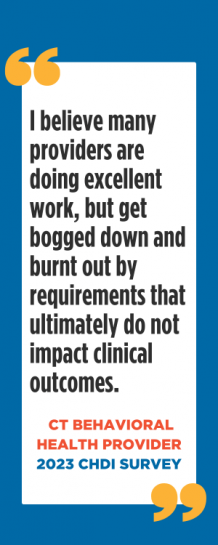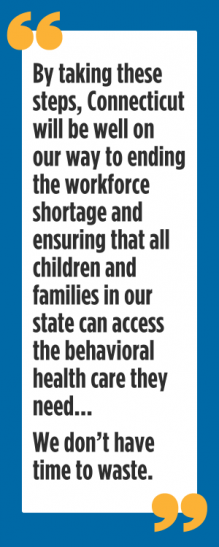
This is the third post in our special blog series taking a closer look at the impact of Connecticut’s behavioral health workforce challenges on children and families – and exploring solutions. Read the rest of the series here.
March 26, 2024
By Jason Lang, Ph.D, Chief Program Officer
Like the rest of the country, Connecticut is facing the dual challenges of increased behavioral health needs among children and a shortage in the workforce providing behavioral health services.* As my colleagues Aleece Kelly, Michael Hoge, and I detailed in a strategic plan published last fall, this is increasing waitlists and delays in care for children and families who need help now.
The strategic plan recommended both short- and long-term strategies to strengthen the behavioral health workforce, but with the legislative session now in full swing, today I’d like to highlight seven steps Connecticut can still take this year to ease the immediate crisis while putting us on a path to becoming a state where every child and family can access behavioral health services, when and where they need them.
First, Connecticut’s nonprofit behavioral health providers need emergency funding to stem the ongoing loss of clinicians and services and prevent wait lists from continuing to increase. As soon as possible, the state should develop a budget for emergency recruitment and retention stipends or grants, along with guidelines and priorities for using these funds.
Based on the needs identified in our strategic planning process, the state should prioritize grants for providers who serve higher proportions of historically marginalized populations and children with complex needs, as well as to support providers using evidence-based, trauma-informed treatments which are shown to be more effective and equitable than usual care.
Other states in New England and around the country have already begun distributing funds to help behavioral health providers recruit and retain staff. Connecticut should join them!
Recommendation 2 in the Strategic Plan details more recruitment and retention strategies the state should consider. And stay tuned for the next post in this series, when CHDI’s Director of Quality Improvement, Jack Lu, Ph.D. will delve further into the importance of keeping the skilled, experienced behavioral health clinicians we already have working in Connecticut.
Compared to other fields, children’s behavioral health providers – especially those who take insurance and serve the state’s highest-need families - are subject to overwhelming administrative mandates and requirements. Over the next year, the state should work with providers to identify and remove unnecessary administrative mandates and requirements that have no impact on quality.
While developing the strategic plan last year, we heard firsthand how this is affecting clinicians in Connecticut. As one survey respondent shared, “I believe many providers are doing excellent work, but get bogged down and burnt out by these requirements that ultimately do not impact clinical outcomes.” Multiple studies have backed this up, finding that excessive administrative work in behavioral healthcare contributes to increased job dissatisfaction, stress, and burnout. 
Of course, some regulations are necessary to ensure high-quality care, but others simply add red tape, costs, redundancy, and frustration without much benefit. Some can even discourage providers from accepting insurance or serve as barriers to entering (or staying in) the field. Addressing these would help to grow and diversify the pipeline, decrease burnout and turnover, and increase access to care for kids.
Specific administrative issues for the state to explore:
Alternatives or changes to the social work licensing exams, which have been criticized for high fees and disparities in pass rates. PA 23-101 addressed some of these issues, but we need to do more to address the disparities.
Removing fees for associate licenses for early career clinicians, who typically earn less and carry higher student loan debt compared to more experienced peers.
Reducing or eliminating license renewal fees for providers serving Medicaid patients as an incentive to accept Medicaid/HUSKY. (We were heartened to see a bill proposed this session that would eliminate licensing fees for all social workers, but it has not yet progressed as of the time of writing).
Participating in more cross-state licensing compacts to immediately expand the pool of available clinicians by enabling licensed professionals from other states to more easily relocate here. (PA 23-101 addressed this for some fields, but not all).
Convening providers and state agencies to identify and remove unnecessary requirements from state contracts that do not impact quality.
Making the pandemic telehealth rules permanent to help nonprofit agencies compete with private practices for staff and expand access to care. (We were pleased to see a bill addressing this issue this session, though as of this writing it only proposed an extension through 2027.)
These recommendations are among the most cost-effective ways the state could immediately strengthen the behavioral health workforce, because in most cases, identifying and addressing them would be a matter of staff or consultant time.
Refer to Recommendation 6 in the Strategic Plan to learn more about administrative barriers impacting the behavioral health workforce.
It’s hard to fix a problem we don’t fully understand. When we're sick and go to the doctor, we expect them to check vital signs, ask about our family history, and order lab tests before diagnosing the problem and prescribing treatment. Once treatment has begun, we expect follow-up visits to monitor and assess how it’s working and make changes as needed.
To strengthen Connecticut’s behavioral health workforce, we need to take a similar approach at a systems level. By tracking system-wide workforce development and children’s behavioral health data – such as service referrals, waitlists, staffing shortages, recruitment and retention activities, and staff training needs – the state could better understand what’s working, what needs improvement, and ultimately develop more effective recruitment, retention, and diversity initiatives. Unfortunately, Connecticut does not currently have an infrastructure in place to manage this.
A dedicated Children’s Behavioral Health Workforce Development Center – like those already in place for fields like nursing - could comprehensively track and analyze statewide data and enable the state to better monitor and respond to trends in the labor market and/or children’s well-being. By more efficiently and effectively targeting resources, the state would also get a bigger bang for its buck.
This year, in collaboration with the Connecticut Children’s Behavioral Health Plan Implementation Advisory Board (CCBHPIAB), the Transforming Children’s Behavioral Health Policy and Planning Committee (TCBHPPC), and other governance groups, the state should begin laying the groundwork for a Behavioral Health Workforce Center by reviewing the infrastructure in other states, identifying the new Center’s specific roles and responsibilities, and developing a five-year plan and budget. These details would then be ready to share with policymakers ahead of the 2025-27 budget process.
As part of this planning process, we can again learn from other states. In 2009, Nebraska established the Behavioral Health Education Center of Nebraska (BHECN) to coordinate the state’s workforce initiatives. Since its inception, Nebraska’s behavioral health workforce has grown by 30%. In 2010, the Alaska Health Workforce Coalition, a public-private partnership comprised of state agencies, universities, and other key stakeholders, completed the Alaska Health Workforce Plan, which established centers dedicated to medical and behavioral health workforce systems.
Minimal resources would be required for this planning stage. And once a Center is established, it will likely be able to leverage any initial state funding to seek supplemental federal and private grants to further expand its work. So let’s get the ball rolling!
Refer to Recommendation 3 in the Strategic Plan for full details on the Center's proposed role.
We all want our tax dollars spent on programs that work. With that in mind, the lead state agencies currently managing initiatives to grow and diversify the behavioral health workforce should annually monitor and publicly report their results. This will enable the state to quickly and transparently determine if a new program is working, identify gaps, and make changes as needed.
In 2022, Connecticut launched two initiatives related to the behavioral health workforce:(1) the CT Health Horizons program currently underway to recruit more educators and provide tuition assistance to nursing and social work students, and (2) new incentive grants through the Office of Higher Education for licensed healthcare providers who become adjunct professors (a response to staff shortages in behavioral health academic programs).
It may take some time to determine how these programs are working, but timely reporting on their outcomes is essential to shaping future policy and funding. Did more students enroll (and graduate and begin working in the field) due to tuition assistance? Did the grants help recruit and retain more educators, and for how long? Was there equitable access to these programs for students and clinicians from underrepresented groups?
Over the next year, the state should closely monitor the impact of these programs and similar ones currently being implemented. In future years, a Behavioral Health Workforce Center (like the one proposed above) could assist with ongoing monitoring and quality improvement.
Refer to Recommendation 4 in the Strategic Plan for more ideas to grow and diversify the behavioral health workforce pipeline.
As we work to grow the children’s behavioral health workforce, it’s important to maintain the quality of care. Staff training in key areas has been shown to not only ensure quality but also increase job satisfaction and recruitment. That’s a win-win!
While Connecticut has some strong training programs, gaps remain. So this year, the state should assess and identify gaps in current training opportunities for child-serving behavioral health providers. Some training areas already identified in our strategic plan include evidence-based treatments, racially and culturally responsive care, supervision and leadership skills, trauma-informed care and family engagement strategies.
It will also be critical to estimate costs, including (1) the direct costs of implementing or expanding various training models and (2) potential indirect costs to agencies (e.g., coverage for out-of-office staff when in training). These costs could be included when calculating new reimbursement rates or alternative payment models, two strategies the state is currently exploring.
Overall, doing the work to identify training needs and estimate costs in 2024 means that legislators and state agencies will have the details they need to act next year.
Stay tuned for a post coming this April from our Quality Improvement team that will further explore workforce training needs. In the meantime, refer to Recommendation 5 in the Strategic Plan for more details and a full list of training needs already identified.
2024 could be an important planning year for expanding peer support and community-based prevention and early intervention initiatives, both of which would help to ease the current crisis.
First, family and peer supports in children’s services (such as those offered by organizations like FAVOR, Inc. or in many schools) have been shown to improve key outcomes and reduce disparities. With appropriate training and supervision, peer support specialists can complement treatment by masters-level clinicians, freeing them up for more intensive cases. Certifying peers also takes less time than focusing solely on increasing the pipeline of masters-level clinicians.
Over the next year, a diverse Peer Support Workforce Workgroup comprised of youth peer mentors, family advocates, providers, and DCF representatives could develop a plan to identify and scale up the most effective family and peer support programs across the state.
Next, expanding the role of community-based organizations in prevention and early intervention activities would be another cost-effective strategy to help prevent or reduce the severity of behavioral health issues in children and youth. The state should also convene a workgroup focused on this area to identify evidence-based practices and develop a statewide plan and budget.
Refer to Recommendations 7 and 8 in the Strategic Plan for more details on how peer support, prevention, and early intervention strategies could help ease the current crisis.
One major caveat to many of these recommendations: before we can expect providers to do more training and data collection, they need funding and higher insurance reimbursement rates that cover the actual costs of providing quality care.
Our last post in this series was a deep dive on the issue of Connecticut’s low Medicaid reimbursement rates for behavioral health services, so I'm not going to spend time rehashing that here. I'll simply reiterate that Connecticut urgently needs to increase Medicaid rates for behavioral health services that reflect the current labor market and the true costs of providing effective services for children.
The state can (and should) develop a more sustainable rate-setting process over the longer term, but an initial increase is needed immediately to help ease the current crisis, get providers back above water, and ensure equitable access to care for children and families.
Refer to Recommendation 1 in the Strategic Plan and read our CEO’s recent blog post to learn more about reimbursement rates.
By taking these seven steps in 2024, Connecticut will be well on our way to ending the current workforce shortage and ensuring that all children and families in our state can access the behavioral health care they need. We don’t have time to waste.
* The behavioral health workforce includes clinical social workers, psychologists, psychiatrists, marriage and family therapists, professional counselors, psychiatric APRNs, addiction counselors, and other behavioral health clinicians. It also includes staff like peer support specialists, aides and technicians, rehabilitation specialists, paraprofessionals, and recovery coaches.
Strategic Plan to Strengthen the Behavioral Health Workforce for Children, Youth, and Families (CHDI Report, co-authored with Michael Hoge of Yale School of Medicine and funded by CT DCF, 2023).
"Advancing Equity in Behavioral Health Through Telemedicine." (CHDI Policy Brief, 2021)
"Improving Early Substance Use Care for Youth: The Essential Role of Outpatient Behavioral Health Clinics." (CHDI Issue Brief, 2023)
"Students Helping Students: School-Based Peer Support Programs Enhance Student Well-Being." (CHDI Issue Brief, 2023)

|
Jason Lang, Ph.D - Chief Program Officer jlang@chdi.org |